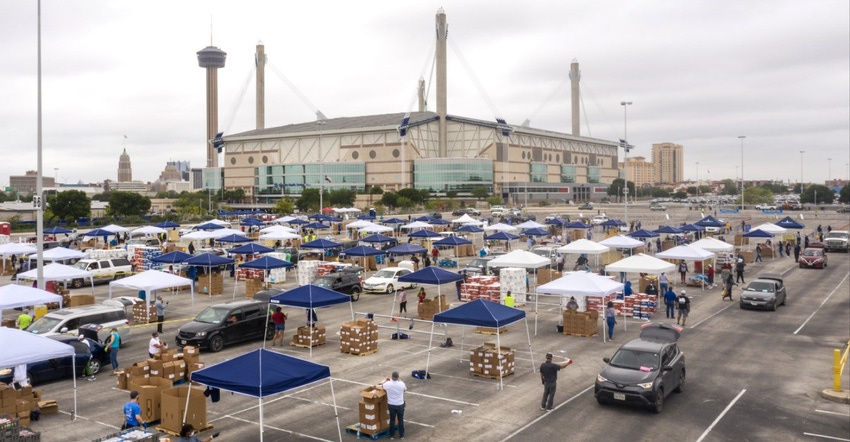USDA rolling out efforts to partner with regional and local distributors to assist in getting food to food banks and nonprofits.

The coronavirus pandemic has affected communities large and small, and the ripple effects could be felt for years to come. School closures and stay-at-home orders have upended household budgets. At the same time, food banks are facing an unprecedented set of circumstances with increased demand, a decline in food donations and fewer volunteers, the Feeding America network explained.
The U.S. Department of Agriculture announced that it is exercising authority under the Families First Coronavirus Response Act to purchase and distribute up to $3 billion of agricultural products to those in need. USDA’s Agricultural Marketing Service (AMS) has begun work to oversee the new Coronavirus Food Assistance Program's (CFAP) USDA Purchase & Distribution Program, also known as the “food boxes†distribution program.
USDA will partner with regional and local distributors whose workforce has been significantly affected by the closure of many restaurants, hotels and other foodservice entities to purchase $3 billion in fresh produce, dairy and meat products. AMS will procure an estimated $100 million per month in fresh fruits and vegetables, $100 million per month in a variety of dairy products and $100 million per month in meat products to provide boxes of fresh produce, dairy and meat products to food banks and other nonprofits serving Americans in need.
The USDA Farmers to Families Food Box Program is open: https://t.co/kDuskkAgWl
— USDA Ag Mktg Service (@USDA_AMS) April 27, 2020
USDA is looking for offers from all over the country to support as many farmers and nonprofits as possible. pic.twitter.com/FoSQxK9g65
The American Farm Bureau Federation and Feeding America, the country’s largest hunger relief organization, sent a letter to USDA requesting a nimble approach to quickly and effectively get food from America’s farms to the nation’s food banks.
Farm Bureau president Zippy Duvall stated, “We applaud the USDA for empowering the private sector to help solve the challenges associated with harvesting, packaging and transporting millions of pounds of food from farms to food banks and other nonprofits working to ensure no one goes hungry.â€
USDA plans to hold a webinar at noon (Eastern) on April 28 to discuss details for the request for proposals. A webinar for farmers, shippers and other suppliers interested in participating in the Farmers to Families Food Box Program will be held at 2 p.m. (Eastern) April 29. This webinar is an opportunity for these parties to learn how to move their produce, dairy and meat products through this new program. (Additional information is found here.)
Food insecurity on the rise
A new report by Feeding America shows that the number of food-insecure children could escalate to 18 million because of the COVID-19 pandemic -- exceeding the highest total USDA has ever reported in the 25 years it has been measuring food insecurity, which was 17.2 million in 2009, at the height of the Great Recession.
The "Impact of the Coronavirus on Child Food Insecurity" report looked at projected annual changes to poverty and unemployment to predict changes to food insecurity rates through a range of scenarios. The analysis was conducted by Dr. Craig Gundersen using the model developed for "Map the Meal Gap," Feeding America’s county-level food insecurity report. An increase in the unemployment rate of 7.6%, coupled with a 5% increase in the child poverty rate, would result in a 9.3% increase in the child food insecurity rate, bringing the total child food insecurity rate potentially to 24.5%. In the wake of the pandemic, that would mean one in four children could face hunger in America this year.
“Whether the food insecurity rate rises to one in four or remains at one in seven, as it currently stands now, it is too many children facing hunger in our country,†Feeding America CEO Claire Babineaux-Fontenot said. “This report should mobilize everyone from our elected officials to the public at large to provide all the resources families need to get through this crisis.â€
According to the most recent USDA report on food security in the U.S., 37.2 million people, including 11.2 million children, did not have adequate access to nutritious food to live a healthy life. A previous analysis Feeding America released earlier this month projected that the total food-insecure population could reach more than 54 million, and this additional analysis indicates that 18 million children would be part of that total.
“This pandemic has brought the plight of so many millions of our neighbors to the forefront,†Babineaux-Fontenot added. “Every car waiting in a distribution line is a family seeking food and encouragement. We will not stop being there for them and ask that if you can support us in our mission, please give what you can.â€
About the Author(s)
You May Also Like




.png?width=300&auto=webp&quality=80&disable=upscale)
